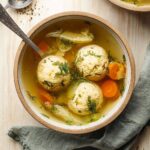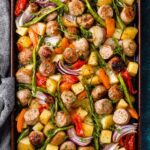Kadai Chicken is a rich and spicy Indian dish where the combination of tender chicken and bold spices is the star. The fresh tomatoes, aromatic ginger, and garlic create a flavorful coating that is perfectly balanced by the heat from the chilies. The stir-fry technique gives it a dry, crispy texture that makes it different from your regular chicken curry.
This dish pairs wonderfully with naan, basmati rice, or even couscous, offering a satisfying meal that’s both flavorful and filling. Garnish it with fresh cilantro and julienned ginger for an extra pop of freshness and flavor. Whether you’re making it for a family dinner or for guests, this Kadai Chicken will definitely impress everyone with its vibrant flavors and textures.
Full Recipe:
-
¼ to ⅓ cup high-smoke-point cooking oil (avocado or peanut oil)
-
1½ lbs skinless, bone-in chicken thighs (cut into small pieces)
-
6 to 8 garlic cloves (crushed or grated)
-
2 tablespoons freshly grated ginger
-
1 lb Roma tomatoes (quartered)
-
1½ teaspoons salt (or to taste)
-
1 teaspoon Kashmiri chili powder (or 2 teaspoons paprika)
-
1½ teaspoons freshly ground black pepper
-
1 teaspoon red pepper flakes
-
1 teaspoon garam masala (divided)
-
½ teaspoon ground cumin (or 1 teaspoon if using cumin seeds)
-
½ teaspoon ground coriander (or 1 teaspoon if using coriander seeds)
-
½ teaspoon ground turmeric
-
2 bay leaves
-
2 green chilies (slit lengthwise, or use serrano peppers)
-
¼ cup chopped cilantro
-
3-inch fresh ginger (julienned, about 3 tablespoons)
-
Optional: ½ teaspoon freshly crushed cumin seeds
-
Optional: ½ teaspoon freshly crushed coriander seeds
-
Optional: 1 tablespoon butter or ghee
Directions:
-
Heat the oil in a wok or shallow cast-iron dish over medium-high heat. Pat the chicken dry and add it to the pan in a single layer. Sear until golden, about 3 to 4 minutes per side.
-
Add crushed garlic and grated ginger, stirring until the raw aroma fades, about 3 to 4 minutes.
-
Add tomatoes, salt, chili powder, black pepper, red pepper flakes, ½ teaspoon garam masala, ground cumin, ground coriander, and turmeric. Stir well. Cook until chicken is tender and tomatoes release juices, about 20-25 minutes. Add bay leaves during cooking.
-
Stir in remaining garam masala, green chilies, cilantro, and julienned ginger. Reduce heat to low-medium and simmer for 5 more minutes, stirring occasionally to thicken the sauce.
-
Stir in the crushed cumin seeds, coriander seeds, and butter (if using). Garnish with remaining cilantro and julienned ginger.
Prep Time: 20 minutes | Cooking Time: 40 minutes | Total Time: 1 hour
Kcal: 212 kcal | Servings: 6 servings
Introduction to Kadai Chicken
Kadai Chicken, also known as Chicken Karahi, is a popular North Indian and Pakistani dish that has captured the hearts of spice lovers worldwide. The dish is famous for its bold, aromatic flavors and unique stir-frying technique, which gives it a distinct texture and taste. Unlike traditional chicken curries, Kadai Chicken is cooked without much sauce, creating a dry, flavorful coating around the chicken. The key to its mouth-watering taste lies in the perfect balance of spices, the high-heat cooking method, and the use of fresh, aromatic ingredients.
The Origin and Cultural Significance of Kadai Chicken
The name “Kadai” refers to the type of cooking vessel traditionally used to prepare the dish: a wok-like iron pan, also called a “karahi.” In Indian and Pakistani cuisine, kadai cooking is a common technique that involves stir-frying food at high temperatures, allowing the spices to infuse the ingredients quickly. This method creates a dish that is dry, flavorful, and rich in texture.
Kadai Chicken is typically served in street-side eateries called “dhabas,” where it is cooked on open flames in large woks. The dish has a deep cultural connection with dhaba-style cooking, known for its rustic flavors and simple, yet hearty preparation. Over time, Kadai Chicken has evolved to suit various regional tastes but has remained a staple in Indian and Pakistani households, often enjoyed with naan, paratha, or basmati rice.
Key Ingredients and Flavor Profile
The flavor profile of Kadai Chicken is deeply influenced by its ingredients. Unlike many Indian dishes that rely heavily on onions and tomatoes for flavor, Kadai Chicken focuses on fresh garlic, ginger, and a variety of whole and ground spices. The dish gets its distinct spiciness from the use of green chilies, red pepper flakes, and Kashmiri chili powder. These ingredients work together to create a bold and peppery kick that defines the dish.
Aromatic spices like cumin, coriander, and garam masala are key to giving Kadai Chicken its complex flavor. The use of cumin and coriander seeds, often crushed fresh before use, adds texture and depth to the dish. Additionally, the use of fresh ginger—both grated and julienned—gives Kadai Chicken its signature fragrance and pungency. The tomatoes in the recipe are not overly juicy; instead, they contribute just enough moisture to coat the chicken with their thick, slightly tangy juices. The high-heat stir-frying process allows the tomatoes to break down and create a thick, flavorful paste that clings to the chicken.
The Cooking Technique: High-Heat Stir-Frying
The most important aspect of preparing Kadai Chicken is the high-heat stir-frying technique used to cook the chicken and spices. Cooking at a high temperature ensures that the chicken sears quickly, locking in its juices, while allowing the spices and tomatoes to infuse the meat. The Maillard reaction, a chemical reaction between amino acids and reducing sugars that occurs when food is cooked at high temperatures, plays a significant role in developing the rich, browned flavor of the chicken.
When searing the chicken, it’s essential to avoid overcrowding the pan, as this can cause the chicken to steam instead of brown. This technique helps to achieve a crispy, slightly caramelized texture on the chicken’s exterior while keeping the inside tender and juicy. The entire cooking process, from searing the chicken to simmering it with spices and tomatoes, takes place in a wok or kadai, which allows for even heat distribution and effective evaporation of excess moisture.
The Importance of Using the Right Equipment
Traditionally, Kadai Chicken is made in a wok-like pan called a “kadai,” which is made of cast iron. This type of pan is known for its ability to retain and distribute heat evenly, making it ideal for stir-frying at high temperatures. Cast iron woks also allow for a quick reduction of liquids, which is essential for the dry-texture finish of the dish. If you don’t have a kadai, a shallow cast-iron skillet or any other heavy-bottomed pan with high heat retention can also work well.
It’s important to use a pan that can withstand high temperatures without warping, as the searing process is essential for the development of flavors. Non-stick pans should be avoided in this recipe, as they do not allow for the necessary high-heat cooking required to achieve the perfect sear and flavor development.
Serving Suggestions and Pairing with Other Dishes
Kadai Chicken is best served hot, straight from the pan. It pairs wonderfully with various Indian flatbreads, such as naan, roti, or paratha, all of which help scoop up the flavorful coating that clings to the chicken. It also pairs perfectly with basmati rice, as the fluffy rice soaks up the spiced juices left in the pan. For a more elaborate meal, serve Kadai Chicken alongside dishes like dal, kachumber salad (a fresh vegetable salad), and a tangy Indian pickle.
While the traditional pairing is with Indian bread or rice, Kadai Chicken can also be enjoyed with more contemporary sides, such as quinoa or couscous, for those looking to try something different. The rich, spiced chicken is sure to be a standout in any meal setting, from family dinners to festive gatherings.
Nutritional Information
Kadai Chicken is a relatively healthy dish, depending on how much oil or ghee you use in the cooking process. The lean protein from the chicken thighs, combined with the spices, provides a flavorful meal without excessive calories or fat. Since the recipe does not rely on any dairy, it is naturally free from lactose, and it can be enjoyed by those following a dairy-free or gluten-free diet. However, as the recipe uses a fair amount of cooking oil, you may want to skim off any excess oil after cooking to make the dish lighter.
Variations and Adaptations
While the classic Kadai Chicken is made with chicken thighs or leg quarters, you can easily adapt the recipe to use other cuts of chicken, such as boneless breasts or even drumsticks. Keep in mind that boneless chicken will cook faster than bone-in pieces, so adjust the cooking time accordingly. For a vegetarian version of Kadai Chicken, you can substitute chicken with paneer (Indian cottage cheese), tofu, or even mixed vegetables such as bell peppers, peas, and carrots.
For those who enjoy a milder version of Kadai Chicken, you can reduce the number of green chilies or omit the red pepper flakes. On the other hand, for those who love extra heat, adding a few more green chilies or a sprinkle of chili powder will intensify the spiciness of the dish. The beauty of Kadai Chicken is in its versatility; you can adjust the spiciness and flavor to suit your personal preference.
Conclusion
Kadai Chicken is a beloved Indian dish that brings together a harmonious blend of spices, tender chicken, and a high-heat cooking technique. Whether you enjoy it in its traditional form or prefer to experiment with variations, this dish is sure to be a hit at your dinner table. Its bold flavors, coupled with its rustic presentation, make it a dish that stands out in any meal. With its rich taste and versatility, Kadai Chicken is a must-try for anyone looking to explore the depths of Indian cuisine.
Whether you’re preparing it for a casual family dinner or a festive gathering, Kadai Chicken is a dish that will always impress and satisfy.





